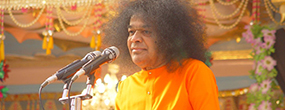
Suspecting trickery, he armed himself with a big stick, approached Sathya, and asked, “Who are You? Are You God, ghost, or devil?” The big moment had arrived and Sathya calmly replied,
“I am Sai.”The stick slowly slipped out of Venkama Raju’s hand but he still remained puzzled. And so he asked: “What are we to do with You?” Sathya replied,
“Worship Me.”The father’s next question was, “When?” Came the answer,
“Every Thursday.”That was when the worship of Sathya Sai first commenced.
One Thursday, someone challenged: “If You are Sai Baba, show us some proof.” Sathya then asked for some flowers. A bunch of jasmine flowers were given to Him. He threw them on the floor; instead of falling randomly, they got neatly arranged to form the words “SAI BABA” in Telugu. Such revelations not withstanding, Sathya was forced to return to Uravakonda and resume school.
Looking back, one can see that starting from the very beginning and particularly from March 1940, Sathya had been gradually setting the stage for what was soon to follow. Right from the time He was a little boy, He had, constantly and consistently, displayed the Divine qualities of compassion, sacrifice, forbearance, and selfless Love.


Occasionally, He performed miracles to drop hints that He was indeed far beyond the normal. Repeatedly He demonstrated His ability to absorb enormous cruelty and physical punishment without any trace of hatred or rancour towards those ill-treating Him. And last but not the least, He constantly diverted the attention of one and all from the mundane to the Divine.
Came finally the day to snap all worldly ties and launch the Mission He had incarnated for. October 20, 1940 was that day. On that morning, Sathya left for school as usual but within minutes He was back home. Standing on the doorstep, He flung aside the bag containing books and in ringing tones declared,
Walking up to a neighbour’s house, He sat on a rock in the middle of the garden there while people flocked, bringing flowers. And then, most lovingly and compassionately Sri Sathya Sai Baba led the congregation in a bhajan that has now become very familiar to us. He sang:
Manasa bhajare Gurucharanam,
Dustara bhavasagara tharanam
O mind! Meditate on the Lotus Feet of the Lord!
That alone will help you to sail across the turbulent sea called life.
The Avatar had finally revealed Himself. Physically, Sai was still a fourteen-year old. Yet, such was His magnetism, and such was the faith of the devotees who flocked to Him that they had no reservation in accepting Him as a Divine Incarnation.
Baba now decided to return to Puttaparthi and make it the base for His Mission. The residents of Uravakonda gave Him a ceremonial and tearful send-off, and Baba was carried in procession. En route, He was joyfully welcomed and worshipped in all the villages that He passed through. Back in Puttaparthi He stayed with His parents for a few days and then shifted to the house of a pious lady named Subbamma, who always had abiding faith in the Divinity of Sathya Sai. Soon, Subbamma’s unostentatious abode became a pilgrim centre.
They came in large numbers to worship Sai, and patiently and tirelessly, Subbamma played hostess to them all. The crowds kept growing bigger and bigger, and a new residence had to be found for Sai. In 1944, Baba moved to a thatched hut in a vacant plot of land nearby. The plot was gifted to Swami by Subbamma. Later the hut was replaced by a tin shed with verandas on either side – this is the famous Paatha Mandiram (Old Mandir) of Puttaparthi folklore.







































